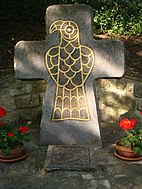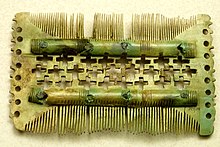Women's grave from Oßmannstedt
Coordinates: 51 ° 0 ′ 37 ″ N , 11 ° 25 ′ 48 ″ E
| Women's grave from Oßmannstedt | ||
|---|---|---|
| location | Thuringia , Germany | |
| Location | Oßmannstedt | |
|
|
||
| When | Second half of the 5th century | |
| Where | Oßmannstedt , district of Weimarer Land / Thuringia | |
| displayed | Museum for Prehistory and Early History of Thuringia in Weimar | |
|
Memorial stone to the grave find of Oßmannstedt, with representation of the eagle brooch |
||
The women's grave of Oßmannstedt was found in 1965 near Oßmannstedt in the Weimarer Land district in Thuringia . It was at an old ford of the Ilm .
Finding circumstances
In 1965, construction work began on the establishment of a stable for LPG animal production in Oßmannstedt on the western outskirts, next to the listed Wielandgut . Settlement pits on the steep bank of the Ilm were already known from the local file , so two archaeologists supervised the earthworks. The construction of a cesspool for the stables also required manual digging, with the workers encountering a burial (a leg bone and parts of the gold chain) at a depth of 2.1 m. The professional and complete recovery is owed to this circumstance. After the enormous scientific importance of the find was made known to the public, the construction workers involved received a fund bonus of 2,300 marks.
Dating
The grave is dated between 454 and 489 AD at the time of the decline of the Huns and the relocation of the Ostrogoths to Italy . The burial is considered evidence of Germanic-equestrian-nomadic relationships in the 2nd half of the 5th century.
Find description
“ The rich, Byzantine-influenced jewelry identifies the dead woman as a member of the Ostrogothic nobility and is a testimony to the increasing art style from the southeast and early Ostrogothic-Danubian relations with the Thuringian area. "
funeral
The woman was buried in a narrow wooden coffin, from which remains were preserved, in a pit over two meters deep. Her wealth makes it evident that she belonged to the nobility.
Finds
Among the additions were:
- a gold, seven centimeter long eagle brooch , the front was provided with 40 almadines in gold cell technology, the back with a gold plate, which shows an eagle as a decorative motif
- a 120 centimeter long gold chain with an amber pearl ,
- a golden kidney-shaped belt buckle of Byzantine-horseman-nomadic provenance with garnet plates in gold cell technology,
- a bag with silver fittings,
- a bone comb with a cross of Danube country provenance,
- a golden finger ring,
- a round, broken white metal mirror in fragments, its diameter was seven centimeters,
- two heavy gold earrings.
- Equestrian nomadic reference
The elite grave of a young woman from the time of the Thuringian Empire around 480 AD testifies to the contact with Ostrogoths . According to equestrian nomadic custom, her head was artificially deformed as a child . This deformation was achieved by continuously wrapping the growing child's head with bandages. She probably lived under Hunnic suzerainty in her youth.
Her gold jewelry - a pair of earrings, a finger ring, a kidney-shaped belt buckle with inlays made of red garnet , a 1.20 meter long chain with an amber pearl and the eagle brooch, as well as a traditionally broken white metal mirror indicate that the young woman belonged to the Ostrogothic elite . Presumably she died on her journey in the Thuringian Empire .
- Eagle brooch
Only a few women wore the eagle brooches from the migration period. Precious filigree garnet discs from Sri Lanka were inserted into the cell structure of the fibula . The goldsmith had naturalistically engraved the eagle's plumage on the back of the fibula base plate. The eagle as a very old symbol of rulership in early Christianity symbolized both the resurrection of Christ and the all-embracing power of the Creator .
literature
- Sigrid Dušek: Prehistory and early history of Thuringia . Theiss, Stuttgart 1999, ISBN 3-8062-1504-9 .
Remarks
- ↑ Die Adlerfiebel von Oßmannstedt In: Neues Deutschland from October 2, 1965
- ^ Günter Behm-Blancke : Gold from the Attila period. In: Prehistory and local research. 3, 1965 pp. 11-14.
- ^ Wolfgang Timpel: Inventory of an Ostrogothic women's grave from Oßmannstedt . In: Historical Commission for Hesse (Ed.): Hesse and Thuringia - from the beginnings to the Reformation. An exhibition by the state of Hesse . Catalog. Wiesbaden 1992, ISBN 3-89258-018-9 , pp. 68 .
- ↑ On the problem of the ethnic interpretation of immigrant grave goods, see: Sebastian Brather : Ethnic interpretations in early historical archeology, history, foundations and alternatives . In: Supplementary volumes to the Reallexikon der Germanischen Altertumskunde . tape 42 . De Gruyter, Berlin / New York 2004.
- ↑ on the problem of the social classification of grave goods from the migration period see: Heiko Steuer : Frühgeschichtliche Sozialstruktur in Mitteleuropa . In: Treatises of the Academy of Sciences in Göttingen, Philological-Historical Class . Third episode 128. Göttingen 1982.
- ↑ Berthold Schmidt: Theodoric the Great and the damascene swords of the Thuringians. In: excavations and finds. 1969 issue 1, pp. 38-40.
- ↑ This was the twenty-second document finding of these artificially deformed skulls in Central Germany, List in Excavations and Finds, 1969, No. 1, p. 39.
- ↑ Another deformed woman's skull (tower skull) from the 5th century was found in 2008 during excavations in Burgweinting, east of Regensburg in Bavaria. Doris Ebner: In: Archeology in Germany . Issue 4 2009 p. 47 the Hunnenkopf from Mannersdorf comes from Austria
- ↑ Doris Ebner: Skull extensions were created by bandaging the head in infancy. In: Archeology in Germany. Issue 4 2009 p. 47.
Web links
- Museum for Pre- and Early History of Thuringia, tower skull of Frau von Oßmannstedt, photographer: Hauke Arnold, © TLDA
- Museum for Pre- and Early History of Thuringia, Eagle Brooch of Frau von Oßmannstedt, photographer: Hauke Arnold, © TLDA
- Archaeological Society in Thuringia eV, Ulrike Trenkmann: The eagle brooch from Oßmannstedt and the cloisonné technique.


